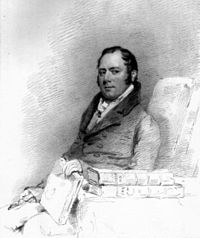George Ormerod
George Ormerod | |
|---|---|
 George Ormerod | |
| Born | 20 October 1785 Manchester, Lancashire, England |
| Died | 9 October 1873 Sedbury, Gloucestershire, England |
| Nationality | English |
| Education | King's School, Chester; Brasenose College, Oxford |
| Occupation | Historian |
| Spouse | Sarah Latham |
| Children | William Piers Ormerod (anatomist); Eleanor Anne Ormerod (entomologist) |
George Ormerod (20 October 1785 – 9 October 1873) was an English antiquary and historian. Amongst his writings was a major account of the history of Cheshire, a county in North West England.
Biography
George Ormerod was born in Manchester and educated first privately, then briefly at the King's School, Chester, before continuing his education privately again under Rev Thomas Bancroft, vicar of Bolton. He matriculated at Brasenose College, Oxford, in 1803, graduated BA in 1806 and received the honorary degree of MA in 1807. In 1806, when he came of age, he inherited extensive estates in Tyldesley and south Lancashire. He married Sarah Latham, the daughter of a doctor in Sandbach in 1808. Following their marriage they first lived in Rawtenstall but moved to Great Missenden the following year.[1] In 1810 he was the tenant at Damhouse in Astley.[2]
By this time he had become involved with research into the history of Cheshire and to make this task easier he bought Chorlton House and estate, which was four miles from Chester.[1] He lived in this house from 1811 to 1823.[3] When this historical work was completed he moved to Gloucestershire, buying the Barnesville estate at Sedbury which he renamed Sedbury Park. He lived there from 1828 until his death. While there, he was appointed as a Justice of the Peace and he served as Deputy Lieutenant for Gloucestershire in 1861. He died at Sedbury Park and was buried nearby at Tidenham.[1]
History of Cheshire
The full title of the work is The history of the county palatine and city of Chester... incorporated with a republication of King's Vale Royal and Leycester's Cheshire antiquities (see Bibliography). An extremely rare initial print in two volumes with duplicated plates was followed by a general subscription in ten parts, which formed three volumes, between 1816 and 1819. Much of his research was from documents held in Chester Castle and from books and documents lent to him by Hugh Cholmondeley, Dean of Chester. He also borrowed material from some of the leading county families. Much of the transcription of these records was performed by Rev. J. Eaton, his research assistant, and by Faithful Thomas, the deputy keeper of the records at Chester Castle. Ormerod made tours of the county and claimed to have visited each township at least once.[1]
Like other county histories of the period, the work consists mainly of family history, manorial history and antiquarian topography. He deliberately excluded reference to commerce, industry and urbanisation. Between a quarter and a third of the work was written by Ormerod himself while the rest consists of transcripts of documents and reprints of earlier works.[1] A second edition of the work, revised and enlarged, was produced by Thomas Helsby and published between 1875 and 1882.
He was elected a Fellow of the Royal Society in 1819.[4]
Career and works
In 1816 Ormerod was responsible for organising the restoration of the Saxon crosses in Sandbach.[5] He later became a founder member of the Historic Society of Lancashire and Cheshire from 1848 and of the Chester Archaeological Society from 1849. He was also a founder Member of the Chetham Society and served as a Member of Council from its foundation in 1843 until 1848.[6] For this society he edited Lancashire Civil War Tracts in 1844 and some other works. Following his move to Gloucestershire he became interested in the antiquities and Roman history of the local area, publishing a series of books and papers, including Strigulensia in 1861, which was about the archaeology of the local region around Chepstow Castle, which in the Middle Ages had been known as "Striguil".[1]
Family
On 2 August 1808, Ormerod married Sarah Latham, the eldest daughter of the physician, John Latham. They had seven sons and three daughters:
- Thomas Johnson Ormerod (1809–74), religious minister.
- George Wareing Ormerod (1810–91), solicitor and geologist.
- John Arderne Ormerod (1813–64), religious minister.
- Susan Mary Ormerod (1814–96), died unmarried.
- Henry Mere Ormerod (1816–98), solicitor.
- William Piers Ormerod (1818–60), anatomist and surgeon.
- Edward Latham Ormerod (1819–73), physician.
- Arthur Stanley Ormerod (1821–84), religious minister.
- Georgiana Elizabeth Ormerod (1822–96), died unmarried.
- Eleanor Anne Ormerod (1828–91), entomologist, died unmarried.[1]
See also
Bibliography
References
- ^ a b c d e f g Crosby, Alan G. (2004), "Ormerod, George (1785–1873)", Oxford Dictionary of National Biography, Oxford University Press, retrieved 20 July 2013 ((subscription or UK public library membership required))
- ^ Tonge, John and Sylvia (2002), Astley Hall Damhouse, John and Sylvia Tonge, p. 13, ISBN 0-9515210-2-0
- ^ de Figueiredo, Peter; Treuherz, Julian (1988), Cheshire Country Houses, Chichester: Phillimore, p. 224, ISBN 0-85033-655-4
- ^ "Library and Archive catalogue". Royal Society. Retrieved 6 March 2012.
- ^ Saxon Crosses, Sandbach Town Council, retrieved 6 April 2007
- ^ "Chetham Society: Officers and Council" (PDF). Chetham Society. 4 November 2015. Retrieved 4 November 2015.
